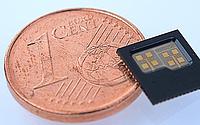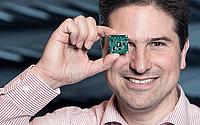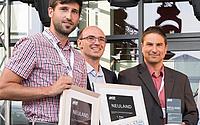A research team led by Prof. Thomas Zwick has worked with industry partners to develop a powerful miniature radar sensor that can make drones smarter and safer for logistics, agriculture or rescue operations.
It’s well known that bats see with their ears. Despite their poor vision, they fly through the night at lightning speed without encountering obstacles. This makes their ability to echolocation possible. In flight, they constantly emit ultrasonic cries that the human ear cannot hear because they are outside the audible frequency range. Each scream moves through space by means of ultrasonic waves. As soon as the waves hit an object or obstacle, they echo back and allow objects to be located and the animals to be oriented. What bats master in perfection is a desirable scenario for the mobility of drones. The unmanned flying objects should recognize their surroundings; move safely and precisely so that they can make work easier in the near future. The use of drones as helpers is already being tested today – from drones for automated fertilization of fields to mail drones for parcel delivery to rescue drones navigating through unsafe and smoky buildings.
In order to make such drones flight-safe and responsive in the future, powerful systems are needed that guarantee accurate and fast-distance measurement around the drone in all dimensions. Unlike bats, the location and distance measurement here are based on electromagnetic waves, known as radar. “In contrast to ultrasound and optical signals, radar waves are more independent of environmental influences such as wind, temperature, light, clouds or even smoke and therefore, function even in bad conditions”, explains Prof. Thomas Zwick, Head of the Institute of High Frequency Technology and Electronics (IHE) at KIT. However, so far there is a lack of radar sensors lightweight and compact enough for an integration into drones that would not affect flight performance.
Engineer Zwick and his research team made a significant contribution to the continuous development of radar sensors. “In several projects, we have researched and further developed a radar-based on silicon-germanium (SiGe) technology. This makes it possible to implement complex, highly integrated circuits and effective antennas for the high-frequency range in a single chip”, explains Zwick. In addition to the chip design, the packaging, i.e. the housing of all components in a stable housing, was a challenge. The 8 x 8 mm housing can be regarded as a successful miniaturization: All high-frequency signals and the production-critical high-frequency connections are fully integrated in a circuit board soldered component, better known as Surface Mount Device (SMD). “For me, the logical conclusion was that the demo chip should become a real product. With the help of our partners, we have realized the world’s first compact radar at 122 GHz, which is commercially available”, Zwick reports. The developed radar sensor, marketed by Silicon Radar GmbH, achieves measurement accuracy down to the double-digit micrometer range – an accuracy previously reserved only for expensive and complex laser systems. As a result, the flatness of surfaces can now be measured using radar.
“The compact technology will open up a lot of new applications”, Zwick is confident. A decisive factor for this is cost-effective production and automated further processing. Due to the standard SMD housing, the radar chip is compatible with common assembly processes. This means that the radar front end can be used by end users in an industrial process even without special knowledge of high-frequency technology. “We are still a long way from mass applications but the measurement performance of our mini-radar will impress especially in particularly demanding measurement tasks compared to lasers. The larger the quantities, the cheaper the chip could be produced”, says expert Zwick.
“With our mini radar, we not only improve measurement performance but also industrial manufacturability. The small size and precise measurement open up completely new possibilities for private sector applications. ”
FUNCTIONAL PRINCIPLE OF A RADAR
The principle of radar technology is similar to the acoustic echo: A transmitter generates high-frequency electromagnetic waves and bundles them into a so-called primary signal. If it hits an object or obstacle, it will reflect back to the radar device like an echo and register there by a receiver. From the time of the waves, distances, velocities and angular positions of moving or stationary objects can be measured with very high accuracy in relation to the radar sensor. Different parameters can also be used to determine properties of the object, such as its size, or, with the help of the Doppler effect, the direction in which the object moves relative to the transmitter. The artificial word radar stands for “Radio Detection and Ranging”.
Further link
Images: KIT







